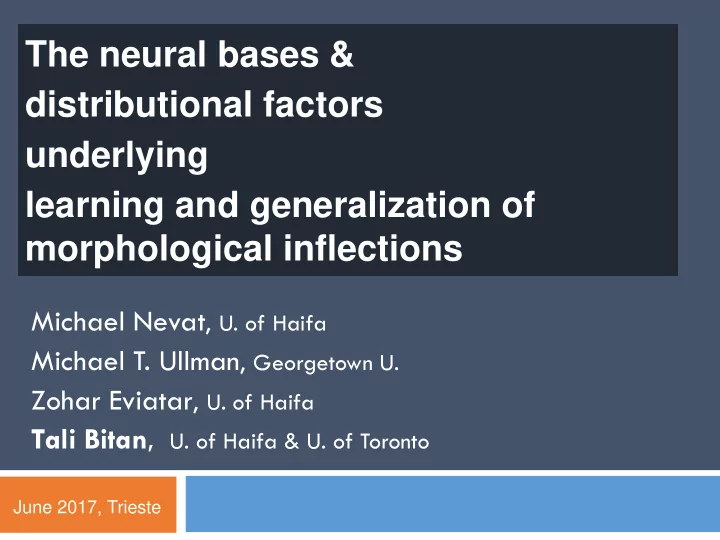

The neural bases & distributional factors underlying learning and generalization of morphological inflections Michael Nevat , U. of Haifa Michael T. Ullman , Georgetown U. Zohar Eviatar , U. of Haifa Tali Bitan , U. of Haifa & U. of Toronto June 2017, Trieste
Goals What are the statistical factors affecting learning of morphological regularities in a 2 nd language? Is there a “ default inflection ” ? Some models suggest that emergence of “ regular ” inflections in L1 does not depend on their statistical properties (e.g., Berent, Pinker & Shimron, 1999; Marcus et al., 1995) Which statistical factors affect emergence of a “ default inflection ” ?
Domain general statistical factors Suffix (type) frequency Repetitions critical for procedural / perceptual learning Shows effects but cannot explain alone emergence of “ default ” . Predictability based on phonological cues Critical in e.g. visual category learning Shows effects, but its role is debated Affix Diversity: number of distinct cues predicting an affix Plays role in generalization from motor, perceptual and category learning May explain emergence of low-frequency “ default ” inflections
The Artificial Language 48 nouns in artificial language “ tuv oz ” + Singular (CVCVC) “ tuv oz an ” 1s Aurally presented + object image Plural ? Plural inflection by suffix: 5 suffixes (VC), varying frequencies: Probabilistic phonological cue: rime- suffix e.g.: “ tuvoz ” “ tuvozan ” ; “ gishoz ” “ gishozan ” . “ nishig ” nishigan ” ; “ posig ” “ posigan ” “ napod ” “ napodesh ” ; “ nezod ” “ nezodesh ” NOT explicit
Experimental groups Group A B C Deterministic Probabilistic Probabilistic N=18 N=18 N=17 Suffix type freq 1 High Freq. 0.375 0.148 ` 0.283 50% (24 words) 1 Medium Freq. 0.125 0.269 0.133 25% (12 words) 3 Low Freq. 0.167 0.194 0.194 8.3% (3 X 4 words ) (each suffix) (each suffix) (each suffix) Suffix frequency – within subject Suffix predictability – within and between subjects Suffix phonological diversity – within and between subjects
Multi-session training Session 1 Sessions 2-5 Sessions 6 + 7 Exposure block Trained-item test Trained- item test Trained- item test 5 training blocks 5 training blocks 5 training blocks Trained-item test Trained-item test Trained-item test Untrained items Untrained-items test: test: with/out rime cues with/out rime cues
Trained words: effect of suffix frequency C A 100 100 100 100 95 95 95 95 90 90 90 90 85 85 85 85 80 80 80 80 High 75 75 75 75 70 70 70 70 Medium 65 65 65 65 Low High 60 60 60 60 Medium 55 55 Low 1 2 3 4 5 6 7 1 2 3 4 5 6 7 50 50 B 1 2 3 4 5 6 7 1 2 3 4 5 6 7 100 100 95 95 Best performance on High 90 90 freq. inflections 85 85 80 80 but Low freq. is better/ 75 75 70 70 equal to Medium. 65 65 60 60 55 1 2 3 4 5 6 7 50 1 2 3 4 5 6 7
Learning of morpho-phonological regularities Application of “ correct ” suffixes to Untrained words with rime cues * * Increase in application of “ correct ” responses
Inflection of untrained words without phonological cues Increase in Application of suffixes to application of Low Untrained words without rime cues frequency suffix Beyond its frequency Probability of suffix usage in trained stimuli Especially in non- deterministic language
Emergence of probabilistic “ default ” Untrained words without rime cues Cosine similarities Initially: Greater reliance on suffix frequency > phonological diversity Later: Increase in reliance on phonological diversity Especially in non- deterministic languages
Experiment 2: fMRI - Goals Which neurocognitive learning mechanisms are involved in learning morphological inflections in a 2 nd language? Procedural? Declarative? Both? Are they affected by these statistical factors Suffix frequency Predictability of phonological cues (Only trained & untrained words with rime cues were tested)
FMRI procedure 18 participants (native Hebrew speakers) Language A Session 1 Sessions 2 Sessions 3 Exposure block Trained- item test Trained- item test Trained-item test 5 training blocks 5 training blocks 5 training blocks Trained-item test Trained-item test Trained-item test Scan: Scan: - Trained items - Trained items - Untrained items with - Untrained items with rime cues rime cues - Baseline: repetition - Baseline: repetition
Early involvement of Fronto-striatal regions Left Caudate Head Trained-Items Transfer % Signal Change 0.4 0.3 0.2 0.1 0 1 3 -0.1 Session Sess. 1: -0.2 Low & Medium > High freq. Caudate nuc. decreases with training: Involved in motor & perceptual learning Nevat, Ullman, Eviatar, & Bitan, (2017) Consistent with procedural skill learning Affected by statistical information: suffix frequency
Untrained > trained words: “ compositional ” Reliance on phonological cues Pre-SMA Medial frontal/ Pre-SMA: 0.6 0.5 Assoc. with procedural 0.4 0.3 0.2 Positive correlation 0.1 0 -0.1 -0.2 Trained-items Transfer Left IFG Triangularis Declarative/ semantic retrieval Negative correlation Correlated with awareness Nevat, Ullman, Eviatar, & Bitan, (2017)
“ Compositional ” areas in trained items In sess. 1: Less in high freq. suffixes. Greater reliance on storage? Nevat, Ullman, Eviatar, & Bitan, (2017)
Conclusion-1 Learning inflectional regularities in a novel language depends on statistical properties: Affix type frequency and phonological predictability When inflecting new words, with no phonological similarity to trained words: A default inflection emerges (even in a novel language) Initially it is the high frequency suffix After learning of phonological regularities – the “ default ” depends on both suffix frequency and suffix phonological diversity.
Conclusions-2 Learning a novel grammar in adults Involves procedural learning mechanisms already in early stages of training. “ Compositionality ” (untrained>trained) involves language production mechanisms and is affected by learning of phonological regularities Familiar (trained) forms with high frequency suffixes are less “ compositional ” .
THANK YOU US-Israel Binational Science Foundation 077/2007 Funded by: to Bitan & Ullman
Recommend
More recommend